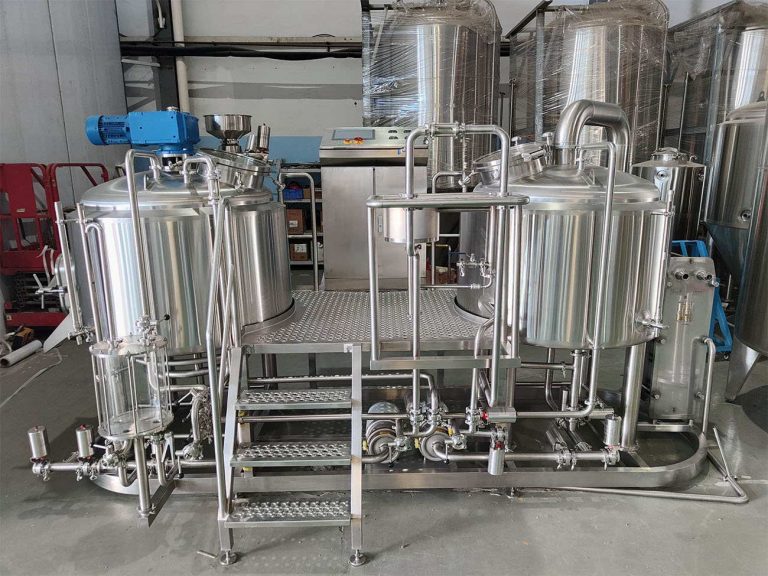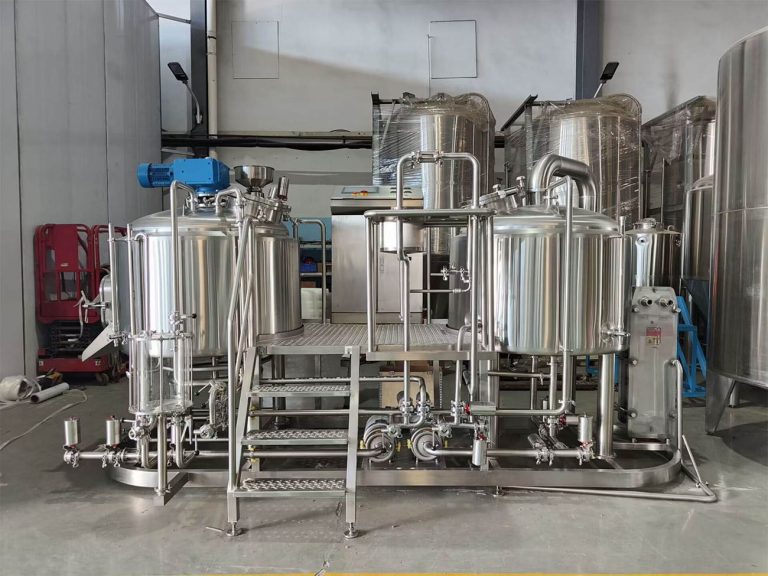

A 3 BBL (barrels) nano brewing system is designed for small-scale commercial beer production, often used by nano breweries, brewpubs, or as a pilot system for larger breweries. This size is ideal for producing craft beer batches with a volume of about 93 gallons per brew.
A 3 BBL (barrels) nano brewing system is designed for small-scale commercial beer production, often used by nano breweries, brewpubs, or as a pilot system for larger breweries. This size is ideal for producing craft beer batches with a volume of about 93 gallons per brew.
2.3BBL Nanobrewery System Specification:
| Output/Brew | 3BBL |
| Brew/Week | 2~6 |
| Output/Week | 6~18BBL |
| Electric Supply | 3phase/380(208, 415,480…)v/50 (60)Hz |
| Heating Source | Electric/Steam |
| Area Request | 30m2-40m2 |
| Brewmaster | 1 |
3.3BBL Nano Brewery System Configuration:
| General specification for 3BBL brewery equipment | ||||
| No. | Name | Components | Capacity | Specification |
| 1 | Grain Milling Unit | Rolling Miller | 80~150kg/hr | Double roller |
| Power:1.1Kw | ||||
| Noise:45±3db | ||||
| 2 | Brewhouse Unit | Mash/Lauter tun | 3BBL (total 610L) | Side mounted grain outdoor with grain chute |
| Laser cutting V-wire False Bottom | ||||
| Kettle/Whirlpool Tun | 3.5BBL (total 790L) | Electric heating; Power: 18kw | ||
| Tangential whirlpool inlet | ||||
| Sanitary leveling sight glass | ||||
| Heat exchanger | 4M2(Effective area) | Completely 304 SS Corrugated plates | ||
| YUY pump | 3M3 | ABB, Sanitary SUS304, VFD control | ||
| Pipe and fittings | As design | completely SS304 | ||
| 3 | Fermentation unit | Fermenter | 3BBL or 6BBL | Dimple cooling jacket on cone and bottom |
| Top manway | ||||
| 60 degree cone bottom | ||||
| Perlick style full sanitary sampling valve | ||||
| Carbonation port and level tube for special request | ||||
| 4 | Bright beer tank | Bright beer tank | 3BBL or 6BBL | Dimple cooling jacket on cone and bottom |
| Level tube for checking | ||||
| Top manway | ||||
| Perlick style full sanitary sampling valve | ||||
| Carbonation port with tri clmap carbonation stone | ||||
| 6 | Glycol Chilling Unit | Glycol Water Tank | 5HL | Insulated conical top and sloped bottom |
| Chiller | 5HPx1PCS | Cooling Capacity: 11000Kcal/5HP | ||
| Installed Power:5.5kw | ||||
| Noise:70-80db | ||||
| Refrigerant: Freon R404A ,R410A | ||||
| Coperland compressor | ||||
| PVC pipe | As designed | Solenoid valves for glycol inlet to tanks are included | ||
| Glycol water pump | 3M3 | Sanitary SUS304, VFD control | ||
| 7 | Control unit | Brewhouse and fermentation
process Controlling |
Floor type | Manual button control panel or PLC control with touch screen for special |
| 8 | CIP | CIP pump with VFD | 3M3 | YUY, VFD control |
| 9 | Keg cleaning | single head | 20-30kegs/hr | Heating: Electric, Power: 15kw |
| 10 | Keg filling | A coupler | Manual | Coupler for filling beer |
| 11 | Bottling line | 4 head | 160-180 bottles/hr | Manual |
| 12 | Others | Option | Can be Customized | Auger System |
| Grain Case | ||||
| Grist Hydrator | ||||
| Piping flow panel for Brewhouse | ||||
A 3 BBL (barrel) nano brewing system offers several advantages for small-scale breweries, brewpubs, or serious homebrewers compared to larger systems or other sizes of nano breweries. Here are some of the key advantages:
Flexibility: A 3 BBL nano brewing system allows brewers to experiment with a wide variety of beer styles and recipes without committing to large production batches. This flexibility is particularly appealing for breweries that prioritize creativity and innovation.
Lower Initial Investment: Compared to larger brewing systems, a 3 BBL nano system requires a lower initial investment in equipment, infrastructure, and space. This makes it more accessible to aspiring brewers or those operating on a tighter budget.
Easier Scaling: Starting with a 3 BBL nano brewing system provides a manageable entry point into commercial brewing while still allowing for future expansion. Brewers can gradually increase production capacity as demand grows, minimizing the risk of overcommitting resources upfront.
Tighter Quality Control: With smaller batch sizes, brewers can maintain tighter control over the brewing process, resulting in more consistent and high-quality beer. They can also more easily experiment with different techniques, ingredients, and brewing parameters to refine their recipes.
Market Differentiation: Nano breweries producing small batches of unique, handcrafted beer can stand out in a crowded market dominated by larger breweries. This niche appeal can attract craft beer enthusiasts looking for distinctive and locally-produced brews.
Community Engagement: Nano breweries often foster stronger connections with their local communities due to their smaller scale and emphasis on craftsmanship. They may host events, offer brewery tours, and collaborate with other businesses or organizations, creating a loyal customer base.
Adaptability: A 3 BBL nano brewing system can be more adaptable to changes in consumer preferences, seasonal demands, or market trends. Brewers can quickly adjust their production schedules and offerings to meet evolving tastes without the constraints of larger batch sizes.
Reduced Waste: Brewing smaller batches can help minimize waste, as brewers can more accurately estimate demand and produce only what is needed. This can lead to lower inventory costs and a more sustainable brewing operation.
5.What factors should be considerations about 3BBL nano brewing system:
Space Requirements: Evaluate the available space for your brewery setup, including brewing area, fermentation space, storage, and potential expansion room. Ensure that the dimensions and layout of the 3 BBL nano brewing system fit within your brewery space comfortably.
Budget: Determine your budget for purchasing the brewing system, including equipment costs, installation, utilities, permits, and any additional expenses. Consider both upfront costs and long-term operational expenses when budgeting for your nano brewery.
Production Capacity: Assess your anticipated production volumes and growth projections to ensure that a 3 BBL nano brewing system can meet your needs. Consider factors such as market demand, distribution channels, and capacity utilization to determine the appropriate size for your brewery.
Equipment Quality and Features: Research different suppliers and manufacturers to compare the quality, features, and reliability of 3 BBL brewing systems. Consider factors such as material construction (e.g., stainless steel), automation level, control systems, warranties, and customer support.
Brewing Process Efficiency: Evaluate the efficiency and workflow of the brewing system, including mash efficiency, lautering, boiling, cooling, fermentation control, and cleaning procedures. Choose a system that streamlines your brewing process and minimizes manual labor.
Utility Needs: Consider the utility requirements, such as water, electricity, and drainage. Brewing involves substantial water usage, and the system will need compatible power sources and proper drainage for waste.
Scalability and Expansion: Consider whether the 3BBL brewing system allows for future growth or if it can be easily expanded if demand increases. This is important for long-term planning and business sustainability.
Support and Service: Check the availability of customer support, maintenance, and servicing for the equipment. Reliable after-sales support can be crucial for resolving issues and ensuring smooth operations.
Conclusion:
A 3bbl nano brewing system offer the advantage of flexibility, allowing brewers to produce a variety of beers without committing to large-scale production. They’re popular among homebrewers looking to take their passion to a slightly larger scale and entrepreneurs interested in starting a small craft brewery.